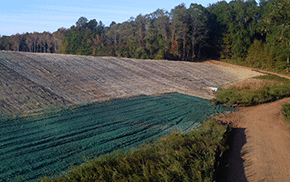Rain Gardens, also called bio-retention areas, are key components for erosion control and stormwater management. Following the EPA\’92s recommendations for low-impact development (LID), rain gardens use natural resources as a way to keep polluted stormwater away from bodies of water.
Recent NPDES Phase II Regulations and the Stormwater Pollution Protection Plan (SWPPP) have placed new importance upon erosion control, stormwater management, and bio-retention areas for use in modern landscaping.
Purpose of Rain Gardens
The main purpose of bio-retention areas is to improve the water quality of nearby streams, creeks, ponds, and lakes by preventing fertilizers and pesticides from entering them. Rain gardens are recessed areas of land typically made of soil, mulch, and native plants. They are designed to accommodate and drain runoff rainwater from nearby structures (roofs, parking lots and driveways). Property owners appreciate both the natural beauty of rain gardens and that they promote drainage (which help to reduce local flooding and damage). Depending upon a property\’92s needs, bio-retention cells can be large or small; they can be designed as several smaller gardens to minimize their overall impact.
Environmental Benefits of Rain Gardens
The EPA has stated that stormwater runoff is a major cause of water pollution today. Rain gardens work to minimize the stormwater runoff and pollutants that enter local rivers, streams and creeks (even the Long Island Sound). Stormwater that sinks into drains and surface waters can cause erosion, pollution, flooding and groundwater problems; rain gardens have been shown to positively reduce the amount of pollution by as much as a third. Rain gardens work to filter out pollutants from entering nearby bodies of water. As they are often planted with native plants, provide food as well, rain gardens also provide shelter for local wildlife.
Constructing Rain Gardens
Bio-retention areas can be designed to fit in with any landscape. Most rain gardens contain the following elements:
- Grass
- Pants
- Mulch or gravel
- Soil
- Sand (to filter out pollutants)
Depending upon their size and complexity, rain gardens can also be built with underdrain systems to direct the filtered excess water to nearby storm drains. Ideally, bio-retention areas should be located at least ten feet (but not more than 30 feet) away from runoff producing structures (such as driveways or roofs) to ensure adequate drainage.
Many shrubs and plants native to Connecticut such as Switchgrass and the Mountain Laurel) are ideal for rain gardens as natives typically need less fertilizer, pesticides, and watering than their exotic counterparts. Additionally, natives typically have extensive root systems that can easily accommodate storm-water drainage.
Key Takeaway
Low Impact Development (LID) and rain gardens are here to stay. The installation of bio-retention areas in a development or community is in compliance with the NPDES Phase II regulations and Storm Water Pollution Protection Plans for reducing water pollution.
All Seasons Landscaping knows rain gardens, native plants and wetlands planting; if your project requires installation of a rain garden, make All Seasons Landscaping your first and last call. We\’92ve been in the business since 1975 and we employ Best Management Practices for effective water pollution control (BMP). As one of the leading landscaping contractors in Connecticut, there\’92s no job too large for us; you can see examples of our work throughout Connecticut and the surrounding states.
Image Courtesy: Free Digital Photos
















